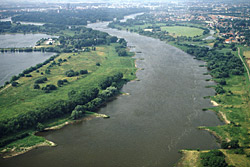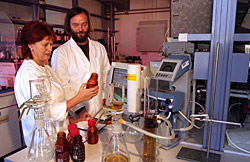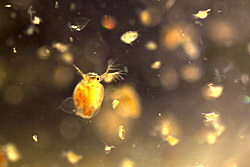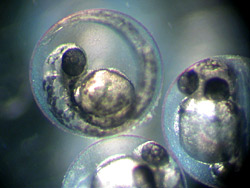Press release 24th February 2005
MODELKEY – The key to clean surface waters
New large-scale EU project researches river ecosystems
Leipzig. Analysing and evaluating chemical pollution – that is the goal of the new European large-scale project MODELKEY, starting in February. Under the management of the Centre for Environmental Research Leipzig-Halle, Germany (UFZ) researchers in 13 countries will be developing methods to identify so-called key chemicals and their effect on the water ecosystem until the year 2010

River Elbe, Germany
Source: Mathias Scholz/UFZ

Elbe, Sandbucht
Source: Andre Kuenzelmann/UFZ

Biomonitoring
Source: Andre Kuenzelmann/UFZ

Bioindicators Water Fleas
Source: Andre Kuenzelmann/UFZ

Bioindicators Fish Eggs
Source: Andre Kuenzelmann/UFZ
Three model rivers will be researched from their source to the mouth: River Elbe (Czech Republic/ Germany), River Schelde (Belgium/ The Netherlands), and River Llobregat (Spain). These three rivers are situated in different climate regions and all suffer from industrial pollution. The findings will later be passed on to all EU member states. The project, involving a total of 25 different research institutions, is subsidised with 8.4 million Euro by the EU. The name of the project, MODELKEY, stands for Models for Assessing and Forecasting the Impact of Environmental Key Pollutants on Marine and Freshwater Ecosystems and Biodiversity. The kick-off for MODELKEY will take place from 28th February to 5th March in Spain.
Background: The EU Water Framework Directive (WFD) has committed all states to see that their surface waters are in good chemical and ecological condition by the year 2015. The goal of the guidelines is to create common standards for surface and groundwater. In this way pollution should be stemmed and the condition of the ecosystem improved in order to protect the water resources in the long-term. The Water Framework Directive has divided the ecological water quality into five grades from bad to very good. By 2015 all surface waters should be of at least grade II (good status). In particular many ecosystems in industrialised regions of Europe have not reached the “good” status. Although the chemical parameters in Germany more or less fulfil the requirements, the Ministry of the Environment sees large deficits in the biological parameters. The job of the MODELKEY project is to find the causes of these problems and develop solutions for them.
Even though the EU has made a priority list of 30 chemicals which are monitored already, the scientists see a need for a much greater field of research. “When you think that there are thousands of different chemical combinations in the environment then it is clear: The current grid is just too wide,” explains Werner Brack from UFZ. “That is why we are trying to combine biological and chemical processes as well as different model techniques so that the spectrum on possible problems can be narrowed down step by step, and to finally identify every connection that really is responsible for harmful effects.” The complete ecosystem will be considered. Do changes to an individual organism affect the whole ecosystem? What does it mean for the ecosystem, when for example a particular fish stops reproducing? These are complex questions which have to be answered by 2010.
The preparation of the long-term project alone took two years. Partners had to be found and a structure had to be created. Michaela Hein and Mechthild
Schmitt coordinate seven sub-projects and over 150 researchers under the lead of Werner Brack. “We have to develop new innovative techniques in all fields,”
Brack paraphrases the coming project. “The challenge is to combine different scientific roots.”
The international research team does not just want to find these key pollutants and explain their effect. The huge volume of data from the surface water
control programme from the EU member states are to be put to use. “At the moment the data are stored in different databases in various formats and are therefore
extremely difficult to handle. That is why we want to create a central database – working closely with the ministries who today collect data and who will later
have to implement the EU Water Framework Directive.” Finally a computer model is to be developed which will offer support to the water authorities in the whole
EU when decisions must be made about which area should be decontaminated and how it can be done most effectively. One thing is clear: The EU Water Framework
Directive means a lot of extra work for the individual member countries.
Leipzig, 24th February 2005
Tilo Arnhold
Further information are available from:
Dr. Werner Brack
Department of Chemical Ecotoxicology
phone: +49 / (0)341 / 235 – 2656
e-mail: werner.brack@ufz.de
Doris Böhme / Tilo Arnhold,
Public Relations of Helmholtz Centre for Environmental Research – UFZ
Phone: +49-341-235-2278
e-mail: presse@ufz.de
MODELKEY
(Model for Assessing and Forecasting the Impact of Enviromental Key Pollutants on Freshwater and Marine Ecosystems and Biodiversity) - beteiligte Partner:
UFZ
Centre for Environmental Research Leipzig-Halle, Germany
UA
University of Antwerp, Belgium
CEFAS
Centre for Environment, Fisheries, and Agriculture, Burnham on Crouch, UK
DELFT
Delft Hydraulics, Delft, The Netherlands
CVR
Consorzio Venezia Ricerche, Venice, Italy
VUA
Vrije Universiteit Amsterdam, The Netherlands
CNRS
Centre National de Recherche Scientifique, Toulouse, France
CSIC
Instituto de Investigaciones Quimicas y Ambientales J.P. Vila Consejo Superior de Investigaciones Cientificas, Barcelona, Spain
UdG
Universitat de Girona, Spain
UB
University of Berne, Switzerland
VRI
Veterinary Research Institute, Brno, Czech Republic
IVB
Institute of Vertebrate Biology, Brno, Czech Republic
UJOE
University of Joensuu, Finland
EWQMA
Elbe Water Quality Monitoring Agency, Hamburg, Germany
RIKZ
National Institute for Coastal and Marine Management, The Hague, The Netherlands
RIVO
Netherlands Institute for Fisheries Research, Wageningen, The Netherlands
SZU
National Research Centre for Dioxins and Related Compounds, Bratislava, Slovak Republic
RIVM
Rijksinstituut voor Volksgezondheid en Milieu, Bilthoven, The Netherlands
UoS
University of Stuttgart, Germany
SPbU
St. Petersburg University, Russia
CWA
Agencia Catalana de l'Aigua, Barcelona, Spain
UdB
University of Barcelona, Barcelona, Spain
ECT
ECT Ökotoxikologie GmbH, Floersheim am Main, Germany
XEN
Xenometrics GmbH, Allschwil, Switzerland
DW
Donabaum & Wolfram OEG Technisches Büro für Ökologie, Vienna, Austria
